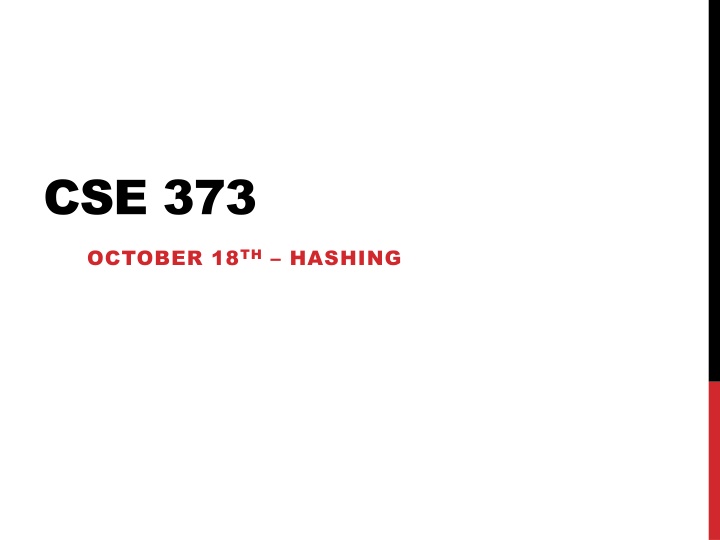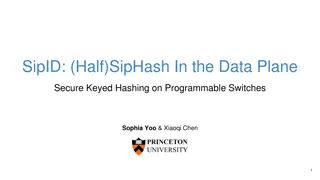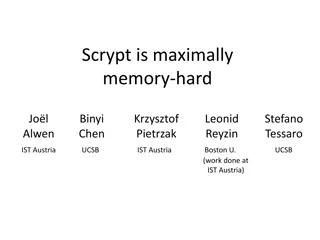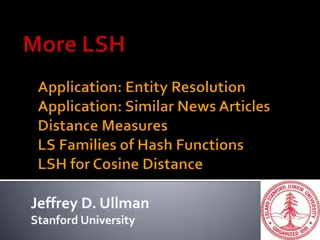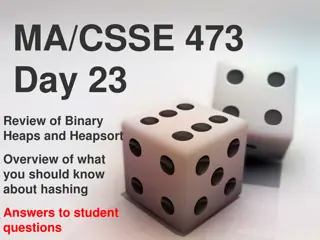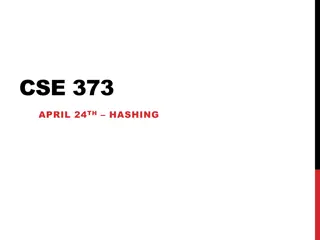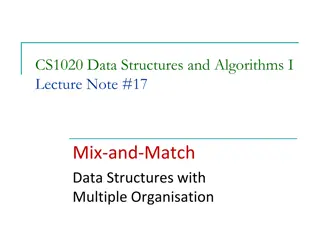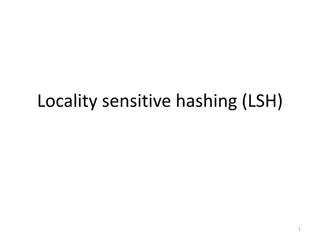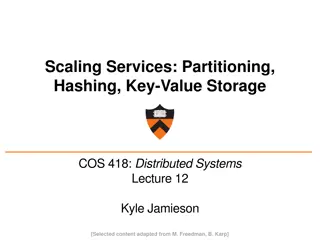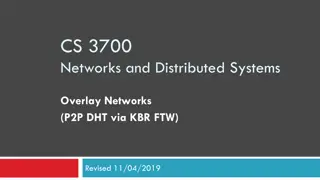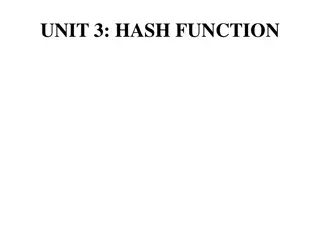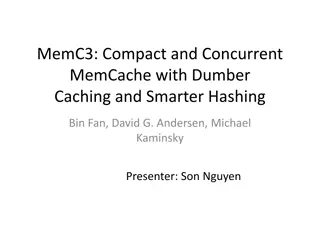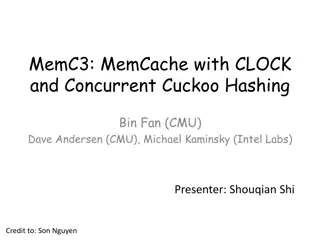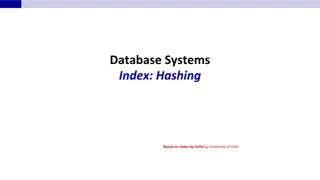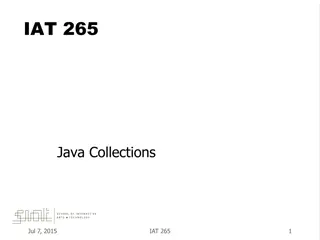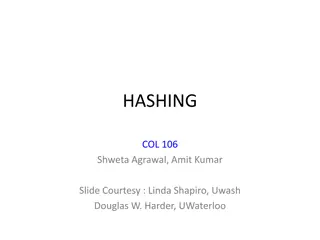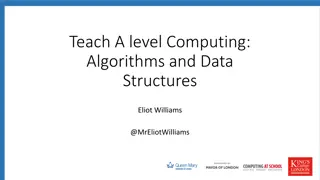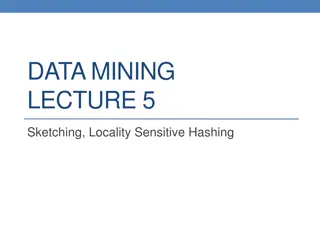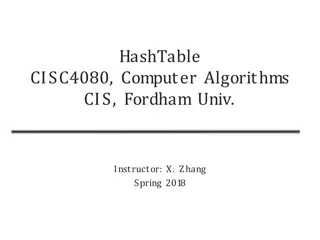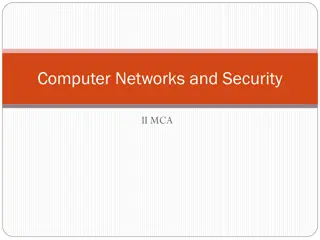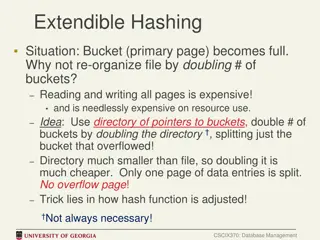Hashing Data Structures
Hashing is a fundamental concept in computer science that involves mapping data from a large space to a target space efficiently using hash functions. In this context, we explore the principles of hashing, ideal data structures, memory considerations, and the role of hash functions in achieving efficient data access and manipulation. The content delves into the concepts of hash tables, probing methods, separate chaining, and implementation considerations to enable effective data storage and retrieval.
Uploaded on Feb 18, 2025 | 2 Views
Download Presentation

Please find below an Image/Link to download the presentation.
The content on the website is provided AS IS for your information and personal use only. It may not be sold, licensed, or shared on other websites without obtaining consent from the author.If you encounter any issues during the download, it is possible that the publisher has removed the file from their server.
You are allowed to download the files provided on this website for personal or commercial use, subject to the condition that they are used lawfully. All files are the property of their respective owners.
The content on the website is provided AS IS for your information and personal use only. It may not be sold, licensed, or shared on other websites without obtaining consent from the author.
E N D
Presentation Transcript
CSE 373 OCTOBER 18TH HASHING
ADMINISTRIVIA Written homework due individually tonight Broken into 5 problems Please resubmit if you have already, this will make grading easier for us
ADMINISTRIVIA Project 2 is out tonight This is a one week project (no checkpoint, so no opportunity for regrading) Start early! Implementing Hashtables and Hashsets Canvas should be configured to allow you to make your own groups, hopefully this will make grade assignments easier
ADMINISTRIVIA Project 1 EC and Part 1 regrades out Friday If you got a different grade than your partner, let me know EC is calculated separately from the rest of the course
TODAYS LECTURE Hashtables Review of probing methods Separate Chaining Implementation considerations
HASHING Introduction Suppose there is a set of data M Any data we might want to store is a member of this set. For example, M might be the set of all strings There is a set of data that we actually care about storing D, where D << M For an English Dictionary, D might be the set of English words
HASHING What is our ideal data structure? The data structure should use O(D) memory No extra memory is allocated The operation should run in O(1) time Accesses should be as fast as possible
HASHING Memory: The Hash Table Consider an array of size c * D Each index in the array corresponds to some element in M that we want to store. The data in D does not need any particular ordering.
HASH FUNCTIONS The Hash Function maps the large space M to our target space D. We want our hash function to do the following: Be repeatable: H(x) = H(x) every run Be equally distributed: For all y,z in D, P(H(y)) = P(H(z)) Run in constant time: H(x) = O(1)
HASH FUNCTION In reality, good hash functions are difficult to produce We want a hash that distributes our data evenly throughout the space Usually, our hash function returns some integer, which must then be modded to our table size Needs to incorporate all the data in the keys
HASH EXAMPLE Possible solutions: Store in the next available space Store both in the same space Try a different hash Resize the array
COLLISIONS Hash table methods are defined by how they handle collisions Two main approaches Probing Chaining
COLLISIONS Probing
COLLISIONS Probing Linear probing
COLLISIONS Probing Linear probing Try the appropriate hash table row first
COLLISIONS Probing Linear probing Try the appropriate hash table row first Increase the index by one until a spot is found
COLLISIONS Probing Linear probing Try the appropriate hash table row first Increase the index by one until a spot is found Guaranteed to find a spot if it is available
COLLISIONS Probing Linear probing Try the appropriate hash table row first Increase the index by one until a spot is found Guaranteed to find a spot if it is available If the array is too full, its operations reach O(n) time. Primary clustering
COLLISIONS Probing Quadratic Probing
COLLISIONS Probing Quadratic Probing Rather than increasing by one each time, we increase by the squares
COLLISIONS Probing Quadratic Probing Rather than increasing by one each time, we increase by the squares k+1, k+4, k+9, k+16, k+25
COLLISIONS Probing Quadratic Probing Rather than increasing by one each time, we increase by the squares k+1, k+4, k+9, k+16, k+25 Certain tables can cause secondary clustering
COLLISIONS Probing Quadratic Probing Rather than increasing by one each time, we increase by the squares k+1, k+4, k+9, k+16, k+25 Certain tables can cause secondary clustering
COLLISIONS Probing Quadratic Probing Rather than increasing by one each time, we increase by the squares k+1, k+4, k+9, k+16, k+25 Certain tables can cause secondary clustering Can fail to insert if the table is over half full
COLLISIONS Probing Secondary Hashing
COLLISIONS Probing Secondary Hashing If two keys collide in the hash table, then a secondary hash indicates the probing size
COLLISIONS Probing Secondary Hashing If two keys collide in the hash table, then a secondary hash indicates the probing size Need to be careful, possible for infinite loops with a very empty array If the secondary hash value and the table size are coprime (they share no factors), then secondary hashing will succeed if there is an open space
COLLISIONS Probing Secondary Hashing If two keys collide in the hash table, then a secondary hash indicates the probing size Need to be careful, possible for infinite loops with a very empty array If the secondary hash value and the table size are coprime (they share no factors), then secondary hashing will succeed if there is an open space If table size is prime, only need to check if hash is a multiple
PRIMALITY Array sizes
PRIMALITY Array sizes We normally choose our hash tables to have prime size
PRIMALITY Array sizes We normally choose our hash tables to have prime size Why?
PRIMALITY Array sizes We normally choose our hash tables to have prime size This is because for any number we pick, so long as it is not a multiple of our table size, they must be coprime
PRIMALITY Array sizes We normally choose our hash tables to have prime size This is because for any number we pick, so long as it is not a multiple of our table size, they must be coprime Two numbers x and y are coprime if they do not share any common factors.
PRIMALITY Array sizes We normally choose our hash tables to have prime size This is because for any number we pick, so long as it is not a multiple of our table size, they must be coprime Two numbers x and y are coprime if they do not share any common factors. If the hash table size and the secondary hash value are coprime, then the search will succeed if there is space available
PRIMALITY Array sizes We normally choose our hash tables to have prime size This is because for any number we pick, so long as it is not a multiple of our table size, they must be coprime Two numbers x and y are coprime if they do not share any common factors. If the hash table size and the secondary hash value are coprime, then the search will succeed if there is space available However, many primes cause secondary clustering when used with quadratic probing
COLLISIONS Chaining
COLLISIONS Chaining Rather than probing for an open position, we could just save multiple objects in the same position
COLLISIONS Chaining Rather than probing for an open position, we could just save multiple objects in the same position Some data structure is necessary here
COLLISIONS Chaining Rather than probing for an open position, we could just save multiple objects in the same position Some data structure is necessary here Commonly: a linked list, AVL tree or secondary hash table.
COLLISIONS Chaining Rather than probing for an open position, we could just save multiple objects in the same position Some data structure is necessary here Commonly: a linked list, AVL tree or secondary hash table. Resizing isn t necessary, but if you don t, you will get O(n) runtime.
LOAD FACTOR When discussing hash table efficiency, we call the proportion of stored data to table size the load factor. It is represented by the Greek character lambda ( ).
LOAD FACTOR When discussing hash table efficiency, we call the proportion of stored data to table size the load factor. It is represented by the Greek character lambda ( ). We ve discussed this a bit implicitly before
LOAD FACTOR When discussing hash table efficiency, we call the proportion of stored data to table size the load factor. It is represented by the Greek character lambda ( ). We ve discussed this a bit implicitly before What are good load-factor ( ) values for each of our collision techniques?
LOAD FACTOR Linear Probing? Quadratic Probing? Secondary Hashing? Chaining?
LOAD FACTOR Linear Probing? Quadratic Probing? Secondary Hashing? Chaining? What are the tradeoffs?
LOAD FACTOR Linear Probing? Quadratic Probing? Secondary Hashing? Chaining? What are the tradeoffs? Memory efficiency
LOAD FACTOR Linear Probing? Quadratic Probing? Secondary Hashing? Chaining? What are the tradeoffs? Memory efficiency Failure rate
LOAD FACTOR Linear Probing? Quadratic Probing? Secondary Hashing? Chaining? What are the tradeoffs? Memory efficiency Failure rate Access times?
LOAD FACTOR Linear Probing? 0.25 < < 0.5 Quadratic Probing? Secondary Hashing? Chaining?
LOAD FACTOR Linear Probing? 0.25 < < 0.5 Quadratic Probing? 0.10 < < 0.30 Secondary Hashing? Chaining?
